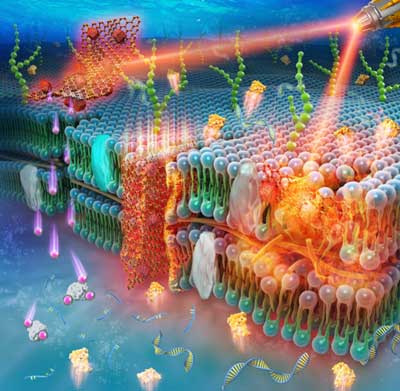Two-dimensional carbon nanosheets derived from metal-organic frameworks for local sterilization and anti-infection treatment
QQ Academic Group: 1092348845
Detailed
Pathogenic infectious diseases have become one of the greatest threats to global public health. In the past few decades, antibiotics have been the most widely used treatment method to solve pathogenic infectious diseases.
However, after long-term abuse of antibiotics, the outbreak of resistant bacteria poses a new and more challenging threat to current anti-infective therapies. Therefore, there is an urgent need to develop novel nanomaterials to fight pathogens through various effects.
Recently, researchers have successfully established various chemical, photothermal or photodynamic antibacterial materials and therapies. However, these single-mode bactericidal therapies are always difficult to effectively or completely eradicate bacterial infections, especially in the case of low concentrations of therapeutic agents.
"Combining multiple treatment modalities with synergies is a promising method to increase antibacterial efficiency and possibly reduce the concentration of the required fungicide," said Dr. Chong Cheng, a researcher at AvH and a biomedical expert in the Department of Chemistry. Free University of Berlin (Germany).

The metal-organic framework-derived 2D carbon nanosheets can achieve effective bacterial elimination and anti-infection treatment by triple sterilization (ie, local large-scale Zn 2+ ion penetration, physical cutting and hyperthermia killing). (Photo: Prof. Dr. Chong Zheng from the Department of Chemistry, Free University of Berlin)
By combining the advantages of two-dimensional graphene and carbon nanomaterials derived from metal-organic framework (MOF), effective local bacterial eradication and anti-infection treatment methods have been introduced in the "Nano Express" Two-dimensional carbon nanosheets for bacterial eradication and enhanced anti-infective treatment").
Fan Xin and Fan Yang of Sichuan University said that these two-dimensional carbon nanosheets (2D-CNs) derived from MOF can spontaneously form aggregates under near-infrared radiation, and also have a local triple sterilization mode, that is, a large amount of local Zn 2 + Ion penetration, physical cutting and hyperthermia killing, they synergistically enhance the destruction of bacterial membranes and intracellular materials.
The most important thing is that 2D-CNs not only have a strong and localized ability to destroy a variety of bacteria at a very low dose, but also have a bactericidal efficiency of nearly 100%, but also can quickly and safely treat the skin by short-term photothermal treatment Wounds are disinfected without damaging normal skin tissue or causing cumulative toxicity.
"Therefore, we believe that this new type of antibacterial 2D-CN has broad prospects and is expected to be widely used as a broad-spectrum antibiotic for killing pathogenic bacteria in many applications, such as clinical skin infection treatment, biomedical equipment sterilization, and water treatment. Disinfection," said Professor Zheng Chong.
However, after long-term abuse of antibiotics, the outbreak of resistant bacteria poses a new and more challenging threat to current anti-infective therapies. Therefore, there is an urgent need to develop novel nanomaterials to fight pathogens through various effects.
Recently, researchers have successfully established various chemical, photothermal or photodynamic antibacterial materials and therapies. However, these single-mode bactericidal therapies are always difficult to effectively or completely eradicate bacterial infections, especially in the case of low concentrations of therapeutic agents.
"Combining multiple treatment modalities with synergies is a promising method to increase antibacterial efficiency and possibly reduce the concentration of the required fungicide," said Dr. Chong Cheng, a researcher at AvH and a biomedical expert in the Department of Chemistry. Free University of Berlin (Germany).

The metal-organic framework-derived 2D carbon nanosheets can achieve effective bacterial elimination and anti-infection treatment by triple sterilization (ie, local large-scale Zn 2+ ion penetration, physical cutting and hyperthermia killing). (Photo: Prof. Dr. Chong Zheng from the Department of Chemistry, Free University of Berlin)
By combining the advantages of two-dimensional graphene and carbon nanomaterials derived from metal-organic framework (MOF), effective local bacterial eradication and anti-infection treatment methods have been introduced in the "Nano Express" Two-dimensional carbon nanosheets for bacterial eradication and enhanced anti-infective treatment").
Fan Xin and Fan Yang of Sichuan University said that these two-dimensional carbon nanosheets (2D-CNs) derived from MOF can spontaneously form aggregates under near-infrared radiation, and also have a local triple sterilization mode, that is, a large amount of local Zn 2 + Ion penetration, physical cutting and hyperthermia killing, they synergistically enhance the destruction of bacterial membranes and intracellular materials.
The most important thing is that 2D-CNs not only have a strong and localized ability to destroy a variety of bacteria at a very low dose, but also have a bactericidal efficiency of nearly 100%, but also can quickly and safely treat the skin by short-term photothermal treatment Wounds are disinfected without damaging normal skin tissue or causing cumulative toxicity.
"Therefore, we believe that this new type of antibacterial 2D-CN has broad prospects and is expected to be widely used as a broad-spectrum antibiotic for killing pathogenic bacteria in many applications, such as clinical skin infection treatment, biomedical equipment sterilization, and water treatment. Disinfection," said Professor Zheng Chong.
- Previous: ACS Nano: Chemical syn
- Next: A Rising 2D Star: Nove


 Academic Frontier
Academic Frontier